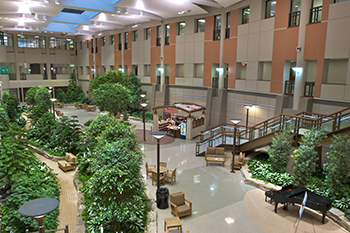Healthy Hospitals Bring the Outdoors Inside
 WEST BLOOMFIELD, Mich. — For many hospitals and clinics, reducing recovery times, decreasing stress and cultivating happier employees tops the institutional wish list. However, rather than hiring consultants and instituting wellness programs, many facilities are opting for a more natural approach.
WEST BLOOMFIELD, Mich. — For many hospitals and clinics, reducing recovery times, decreasing stress and cultivating happier employees tops the institutional wish list. However, rather than hiring consultants and instituting wellness programs, many facilities are opting for a more natural approach.
Indoor healing or therapeutic gardens are now blooming in hospitals, outpatient clinics, substance abuse facilities and hospice settings across the country. Where health care providers once relied on potted plants and landscaped entryways, many are now dedicating interiors to lush, living oases, and seeing some serious benefits.
Roger Ulrich, now an environmental psychologist at Texas A&M University, was one of the first to examine how integrating nature into health care settings could positively impact patients. Ulrich specifically studied patients recovering from gall bladder surgery. The only distinct difference in their treatment and recovery was the view from their hospital room. Ulrich found that patients who enjoyed a view of nature typically required less pain medication, experienced fewer complications and healed a full day faster than their counterparts who faced brick walls.
In 2008, researchers at Kansas State University published similar findings. They found that patients recovering from appendectomies in rooms containing plants and flowers required significantly fewer postoperative analgesics, and had more positive physiological responses when compared to patients in the flora-free control group.
Shane Pliska, president of the interior landscape design firm Planterra, enthusiastically supports these findings. Pliska and the Planterra team have completed multiple garden installations in health care facilities across the country, and believe their work has an important impact on physical and psychological health.
“We need plants,” Pliska said. “People are stressed in medical facilities, whether it’s because of their own illness or a loved one’s [illness]. When they have nature in sight, when there are plants in those spaces, it makes people feel more comfortable. It relates to the human element of what we’re doing.”
In 2012, Scientific American magazine also noted the increased use of healing gardens in hospitals and clinics, referencing design standards developed by Susan Rodiek, also of Texas A&M. According to Rodiek, lush, layered and diverse garden installations with a minimum of concrete interruptions are most conducive to healing and engagement. The gardens should also stimulate multiple senses, be easily accessible and feature realistic sculptures as opposed to abstract images.
These living green spaces can be integrated into nearly any hospital or clinical setting. Many facilities concentrate healing gardens in atriums or entryways; however seating areas, collaborative spaces and corridors can also serve as ideal venues for containerized installations. According to Pliska, Planterra designers have even converted defunct interior fountains into lush gardens.
Living installations are also a safe option for sterile environments. Planterra and other interior garden designers often use a sub-irrigation system and sterilized growing media as opposed to traditional soil. This prevents water from being exposed to air. Meanwhile, the plants add to the overall air quality of the space by creating new oxygen rather than simply filtering it.
For example, at Planterra’s Henry Ford Hospital installation in West Bloomfield, Mich., two plant-filled atriums act as the facility’s lungs. Together they include roughly 2,500 live, oxygen-generating plants, which can be easily viewed from numerous patient rooms. The atriums also serve as important gathering spaces for large or small groups, offering more intimate conversation and reflection spaces.
Henry Ford Hospital President and CEO Gerard Van Grinsven also considers the garden an important extension of the hospital’s mission. “Even in the offseason time, our community can come here and be connected to nature, and really take advantage of its healing effects,” he said.
